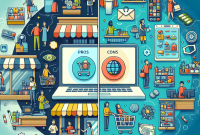
E-Commerce Gamification: Engaging Shoppers Through Interactive Elements
-
Table of Contents
- Introduction
- How to Use Gamification to Increase Customer Engagement in E-Commerce
- Exploring the Benefits of E-Commerce Gamification for Businesses
- Strategies for Designing Engaging E-Commerce Gamification Experiences
- The Impact of E-Commerce Gamification on Shopping Habits
- Analyzing the Effectiveness of E-Commerce Gamification for Customer Retention
- Q&A
- Conclusion
“Unlock the Fun of Shopping: Experience E-Commerce Gamification!”
Introduction
E-commerce gamification is a powerful tool for engaging shoppers and driving sales. It involves the use of interactive elements such as games, rewards, and challenges to create an engaging shopping experience. By leveraging the power of game mechanics, e-commerce gamification can help to increase customer loyalty, boost engagement, and drive sales. It can also be used to create a more personalized shopping experience, as well as to provide customers with incentives to purchase. With the right strategy, e-commerce gamification can be an effective way to increase customer engagement and drive sales.
How to Use Gamification to Increase Customer Engagement in E-Commerce
As e-commerce continues to grow, businesses must find ways to stand out from the competition and increase customer engagement. One way to do this is through gamification, which is the use of game-like elements in non-game contexts. Gamification can be used to create a more engaging and interactive customer experience, leading to increased customer loyalty and engagement.
One way to use gamification in e-commerce is to create a loyalty program. Loyalty programs reward customers for their purchases and encourage them to keep coming back. For example, a business could offer points for every purchase, which can be redeemed for discounts or other rewards. This encourages customers to keep coming back and makes them feel valued.
Another way to use gamification in e-commerce is to create a leaderboard. Leaderboards can be used to track customer activity, such as purchases, reviews, or referrals. Customers can be rewarded for their activity, such as discounts or exclusive offers. This encourages customers to stay engaged and compete with each other, leading to increased customer loyalty.
Finally, businesses can use gamification to create a more interactive customer experience. For example, businesses can create quizzes or surveys that customers can complete to earn rewards. This encourages customers to interact with the business and provides valuable feedback.
Gamification can be a powerful tool for increasing customer engagement in e-commerce. By creating loyalty programs, leaderboards, and interactive experiences, businesses can create a more engaging customer experience and increase customer loyalty.
Exploring the Benefits of E-Commerce Gamification for Businesses
The world of e-commerce is constantly evolving, and businesses must stay ahead of the curve to remain competitive. One of the latest trends in e-commerce is the use of gamification, which is the application of game-like elements to non-game contexts. Gamification can be used to engage customers, increase sales, and improve customer loyalty. In this blog post, we’ll explore the benefits of e-commerce gamification for businesses.
First, gamification can be used to engage customers. By incorporating game-like elements into the shopping experience, businesses can make it more enjoyable and engaging for customers. This can lead to increased customer loyalty and more repeat purchases. Additionally, gamification can be used to reward customers for their loyalty. For example, businesses can offer rewards for completing certain tasks or reaching certain milestones. This can encourage customers to keep coming back and make more purchases.
Second, gamification can be used to increase sales. By offering rewards for completing certain tasks or reaching certain milestones, businesses can encourage customers to make more purchases. Additionally, gamification can be used to create a sense of competition among customers. This can lead to increased sales as customers strive to outdo each other.
Finally, gamification can be used to improve customer loyalty. By offering rewards for completing certain tasks or reaching certain milestones, businesses can create a sense of loyalty among customers. Additionally, gamification can be used to create a sense of community among customers. This can lead to increased customer loyalty as customers feel more connected to the business.
In conclusion, e-commerce gamification can be a powerful tool for businesses. It can be used to engage customers, increase sales, and improve customer loyalty. By incorporating game-like elements into the shopping experience, businesses can make it more enjoyable and engaging for customers. Additionally, businesses can use gamification to reward customers for their loyalty and create a sense of competition and community among customers. If you’re looking for ways to improve your e-commerce business, gamification may be the answer.
Strategies for Designing Engaging E-Commerce Gamification Experiences

Gamification is an increasingly popular way to engage customers and increase sales in the e-commerce space. By incorporating game elements into the shopping experience, businesses can create a more enjoyable and rewarding experience for their customers. Here are some strategies for designing engaging e-commerce gamification experiences:
1. Offer Rewards: Offering rewards for completing certain tasks or reaching certain milestones is a great way to incentivize customers to keep coming back. Rewards can be anything from discounts to exclusive products or services.
2. Create Challenges: Challenges are a great way to engage customers and keep them coming back. Create challenges that are achievable but still require some effort to complete. This will keep customers engaged and motivated to keep playing.
3. Use Leaderboards: Leaderboards are a great way to create competition and encourage customers to keep playing. Customers can compete against each other to reach the top of the leaderboard and earn rewards.
4. Personalize the Experience: Personalizing the experience for each customer is key to creating an engaging gamification experience. Use customer data to tailor the experience to each individual customer and make it more relevant and engaging.
5. Make it Fun: Above all, make sure the experience is fun. Incorporate elements of humor and surprise to keep customers engaged and coming back for more.
By following these strategies, businesses can create an engaging and rewarding e-commerce gamification experience that will keep customers coming back for more.
The Impact of E-Commerce Gamification on Shopping Habits
The rise of e-commerce has revolutionized the way we shop. From the convenience of online shopping to the vast selection of products available, it’s no wonder that e-commerce has become so popular. But what if there was a way to make online shopping even more enjoyable? Enter e-commerce gamification.
Gamification is the process of adding game-like elements to an activity to make it more engaging and enjoyable. In the context of e-commerce, this could include things like loyalty points, leaderboards, and rewards for completing certain tasks. By introducing these elements, e-commerce gamification can make shopping more fun and rewarding.
But how does e-commerce gamification affect shopping habits? Studies have shown that gamification can have a positive impact on consumer behavior. For example, loyalty points can encourage customers to shop more frequently and spend more money. Leaderboards can create a sense of competition, motivating customers to purchase more items. And rewards can incentivize customers to complete certain tasks, such as signing up for a newsletter or referring a friend.
Overall, e-commerce gamification can be a powerful tool for driving customer engagement and loyalty. By making shopping more fun and rewarding, it can encourage customers to shop more often and spend more money. For e-commerce businesses, this can lead to increased sales and a larger customer base.
So if you’re looking to boost your e-commerce business, consider introducing some game-like elements to your website. With the right gamification strategy, you can make shopping more enjoyable for your customers and increase your sales.
Analyzing the Effectiveness of E-Commerce Gamification for Customer Retention
The use of gamification in e-commerce is becoming increasingly popular as a way to engage customers and increase customer retention. Gamification is the process of applying game-like elements to non-game activities, such as shopping, to make them more enjoyable and engaging. By introducing elements such as points, rewards, and leaderboards, e-commerce businesses can create a more interactive and rewarding shopping experience for their customers.
But how effective is gamification for customer retention? To answer this question, we need to look at the evidence. Studies have shown that gamification can be an effective tool for increasing customer engagement and loyalty. For example, one study found that customers who participated in a gamified loyalty program were more likely to make repeat purchases than those who did not.
In addition, research has shown that gamification can be an effective way to increase customer satisfaction. Customers who participate in gamified loyalty programs are more likely to report higher levels of satisfaction with their shopping experience. This is likely due to the fact that gamification makes the shopping experience more enjoyable and engaging.
Finally, gamification can also be an effective way to increase customer loyalty. Customers who participate in gamified loyalty programs are more likely to remain loyal to the brand and make repeat purchases. This is likely due to the fact that customers feel rewarded and appreciated for their loyalty.
Overall, the evidence suggests that gamification can be an effective tool for increasing customer engagement, satisfaction, and loyalty. By introducing elements such as points, rewards, and leaderboards, e-commerce businesses can create a more interactive and rewarding shopping experience for their customers. This can help to increase customer retention and ultimately lead to increased sales and profits.
Q&A
1. What is e-commerce gamification?
E-commerce gamification is the use of game-like elements and mechanics to engage shoppers and encourage them to interact with a website or online store. It can include elements such as leaderboards, rewards, points, badges, and challenges.
2. What are the benefits of e-commerce gamification?
E-commerce gamification can help to increase customer engagement, loyalty, and sales. It can also help to create a more enjoyable shopping experience, which can lead to increased customer satisfaction and repeat purchases.
3. How can e-commerce gamification be used?
E-commerce gamification can be used in a variety of ways, such as offering rewards for completing tasks, providing points for purchases, and creating leaderboards to show customers how they compare to other shoppers.
4. What are some examples of e-commerce gamification?
Some examples of e-commerce gamification include offering rewards for completing tasks, providing points for purchases, and creating leaderboards to show customers how they compare to other shoppers. Other examples include offering discounts for completing challenges, providing badges for completing levels, and offering rewards for referring friends.
5. What are the best practices for implementing e-commerce gamification?
The best practices for implementing e-commerce gamification include setting clear goals, creating engaging content, and providing rewards that are meaningful to customers. Additionally, it is important to ensure that the gamification elements are easy to understand and use, and that they are integrated into the overall shopping experience.
Conclusion
E-Commerce Gamification is an effective way to engage shoppers and increase sales. By incorporating interactive elements such as leaderboards, rewards, and challenges, businesses can create an engaging shopping experience that encourages customers to return and purchase more. With the right strategy, businesses can use gamification to create a fun and rewarding shopping experience that will keep customers coming back.






